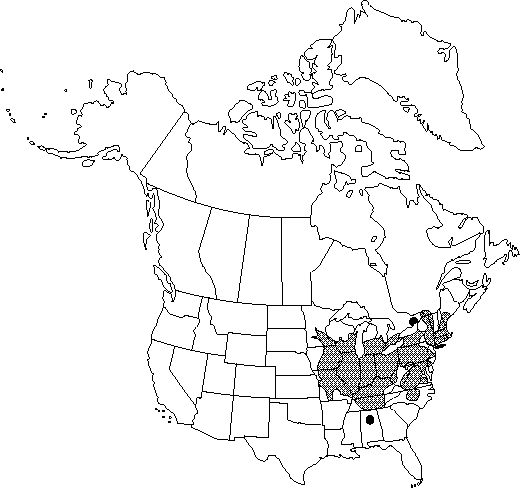Difference between revisions of "Quercus bicolor"
in G. H. E. Muhlenberg, Ges. Naturf. Freunde Berlin Neue Schriften 3: 396. 1801.
FNA>Volume Importer |
FNA>Volume Importer |
||
| Line 17: | Line 17: | ||
|basionyms= | |basionyms= | ||
|synonyms={{Treatment/ID/Synonym | |synonyms={{Treatment/ID/Synonym | ||
| − | |name= | + | |name=Quercus bicolor var. angustifolia |
|authority=Dippel | |authority=Dippel | ||
| − | }}{{Treatment/ID/Synonym | + | }} {{Treatment/ID/Synonym |
| − | |name= | + | |name=Quercus bicolor var. cuneiformis |
|authority=Dippel | |authority=Dippel | ||
| − | }}{{Treatment/ID/Synonym | + | }} {{Treatment/ID/Synonym |
| − | |name= | + | |name=Quercus bicolor var. platanoides |
|authority=A. de Candolle | |authority=A. de Candolle | ||
| − | }}{{Treatment/ID/Synonym | + | }} {{Treatment/ID/Synonym |
| − | |name= | + | |name=Quercus platanoides |
|authority=unknown | |authority=unknown | ||
}} | }} | ||
| Line 43: | Line 43: | ||
|elevation=0-1000 m | |elevation=0-1000 m | ||
|distribution=Ont.;Que.;Ala.;Conn.;Del.;Ill.;Ind.;Iowa;Ky.;Maine;Md.;Mass.;Mich.;Minn.;Mo.;N.H.;N.J.;N.Y.;N.C.;Ohio;Pa.;R.I.;Tenn.;Vt.;Va.;W.Va.;Wis. | |distribution=Ont.;Que.;Ala.;Conn.;Del.;Ill.;Ind.;Iowa;Ky.;Maine;Md.;Mass.;Mich.;Minn.;Mo.;N.H.;N.J.;N.Y.;N.C.;Ohio;Pa.;R.I.;Tenn.;Vt.;Va.;W.Va.;Wis. | ||
| − | |discussion=<p>Putative hybrids between Quercus bicolor and Q. macrocarpa are common in areas of contact. The hybrids tend to have more deeply lobed leaves and varying degrees of development of awns as a fringe along the margin of the acorn cup. Such characteristics occur sporadically throughout many populations of Q. bicolor; in some cases they may occur because of subtle introgression.</p><!-- | + | |discussion=<p>Putative hybrids between <i>Quercus bicolor</i> and <i>Q. macrocarpa</i> are common in areas of contact. The hybrids tend to have more deeply lobed leaves and varying degrees of development of awns as a fringe along the margin of the acorn cup. Such characteristics occur sporadically throughout many populations of <i>Q. bicolor</i>; in some cases they may occur because of subtle introgression.</p><!-- |
| − | --><p>The Iroquois used Quercus bicolor in the treatment of cholera, broken bones, consumption, and as a witchcraft medicine (D. E. Moerman 1986).</p> | + | --><p>The Iroquois used <i>Quercus bicolor</i> in the treatment of cholera, broken bones, consumption, and as a witchcraft medicine (D. E. Moerman 1986).</p> |
|tables= | |tables= | ||
|references= | |references= | ||
| Line 57: | Line 57: | ||
|rank=species | |rank=species | ||
|parent rank=section | |parent rank=section | ||
| − | |synonyms= | + | |synonyms=Quercus bicolor var. angustifolia;Quercus bicolor var. cuneiformis;Quercus bicolor var. platanoides;Quercus platanoides |
|basionyms= | |basionyms= | ||
|family=Fagaceae | |family=Fagaceae | ||
| Line 68: | Line 68: | ||
|publication year=1801 | |publication year=1801 | ||
|special status=Endemic;Selected by author to be illustrated | |special status=Endemic;Selected by author to be illustrated | ||
| − | |source xml=https://jpend@bitbucket.org/aafc-mbb/fna-data-curation.git/src/ | + | |source xml=https://jpend@bitbucket.org/aafc-mbb/fna-data-curation.git/src/8f726806613d60c220dc4493de13607dd3150896/coarse_grained_fna_xml/V3/V3_385.xml |
|genus=Quercus | |genus=Quercus | ||
|section=Quercus sect. Quercus | |section=Quercus sect. Quercus | ||
Revision as of 17:16, 18 September 2019
Trees, deciduous, to 30 m. Bark dark gray, scaly or flat-ridged. Twigs light brown or tan, 2-3(-4) mm diam., glabrous. Buds light or dark brown, globose to ovoid, 2-3 mm, glabrous. Leaves: petiole (4-)10-25(-30) mm. Leaf blade obovate to narrowly elliptic or narrowly obovate, (79-)120-180(-215) × (40-)70-110(-160) mm, base narrowly cuneate to acute, margins regularly toothed, or entire with teeth in distal 1/2 only, or moderately to deeply lobed, or sometimes lobed proximally and toothed distally, secondary veins arched, divergent, (3-)5-7 on each side, apex broadly rounded or ovate; surfaces abaxially light green or whitish, with minute, flat, appressed-stellate hairs and erect, 1-4-rayed hairs, velvety to touch, adaxially dark green, glossy, glabrous. Acorns 1-3(-5) mm, on thin axillary peduncle (20-)40-70 mm; cup hemispheric or turbinate, 10-15 mm deep × 15-25 mm wide, enclosing 1/2-3/4 nut, scales closely appressed, finely grayish tomentose, those near rim of cup often with short, stout, irregularly recurved and sometimes branched, spinose awns emerging from tubercle; nut light brown, ovoid-ellipsoid or oblong, (12-)15-21(-25) × 9-18 mm, glabrous. Cotyledons distinct. 2n = 24.
Phenology: Flowering in spring.
Habitat: Low swamp forests, moist slopes, poorly drained uplands
Elevation: 0-1000 m
Distribution

Ont., Que., Ala., Conn., Del., Ill., Ind., Iowa, Ky., Maine, Md., Mass., Mich., Minn., Mo., N.H., N.J., N.Y., N.C., Ohio, Pa., R.I., Tenn., Vt., Va., W.Va., Wis.
Discussion
Putative hybrids between Quercus bicolor and Q. macrocarpa are common in areas of contact. The hybrids tend to have more deeply lobed leaves and varying degrees of development of awns as a fringe along the margin of the acorn cup. Such characteristics occur sporadically throughout many populations of Q. bicolor; in some cases they may occur because of subtle introgression.
The Iroquois used Quercus bicolor in the treatment of cholera, broken bones, consumption, and as a witchcraft medicine (D. E. Moerman 1986).
Selected References
None.
